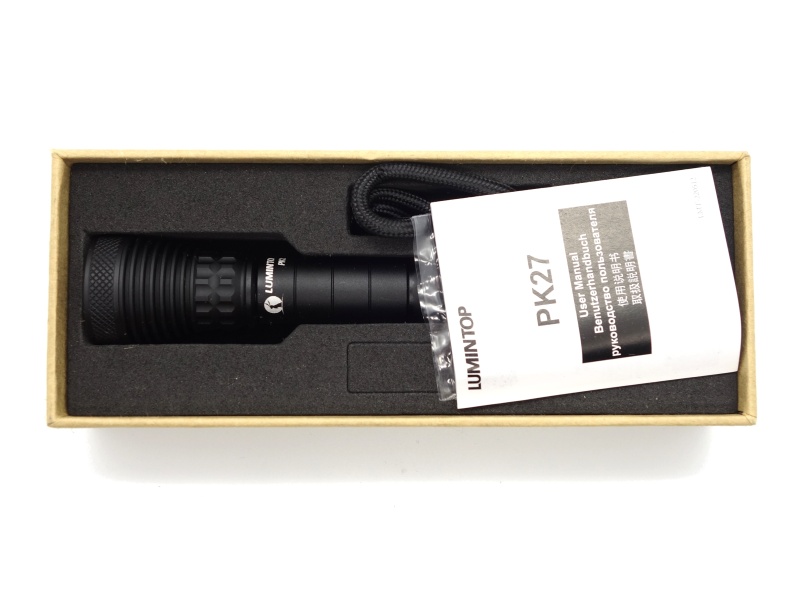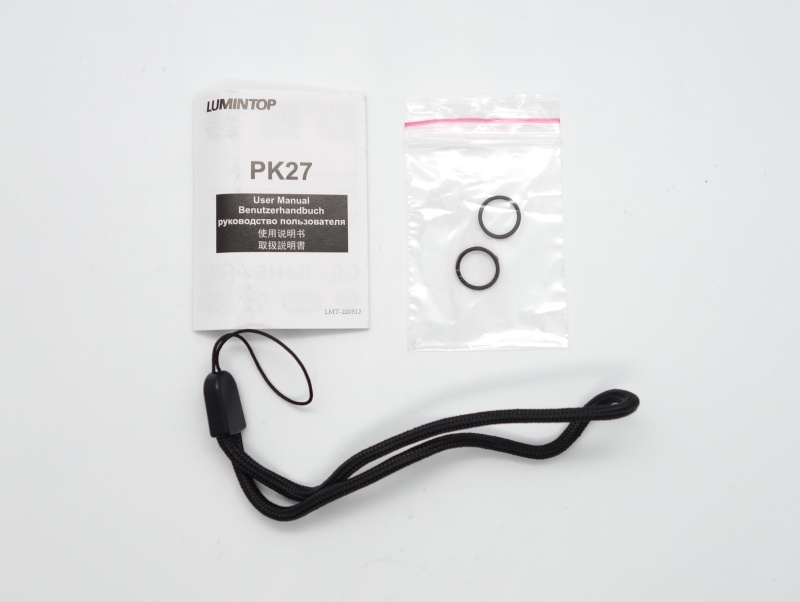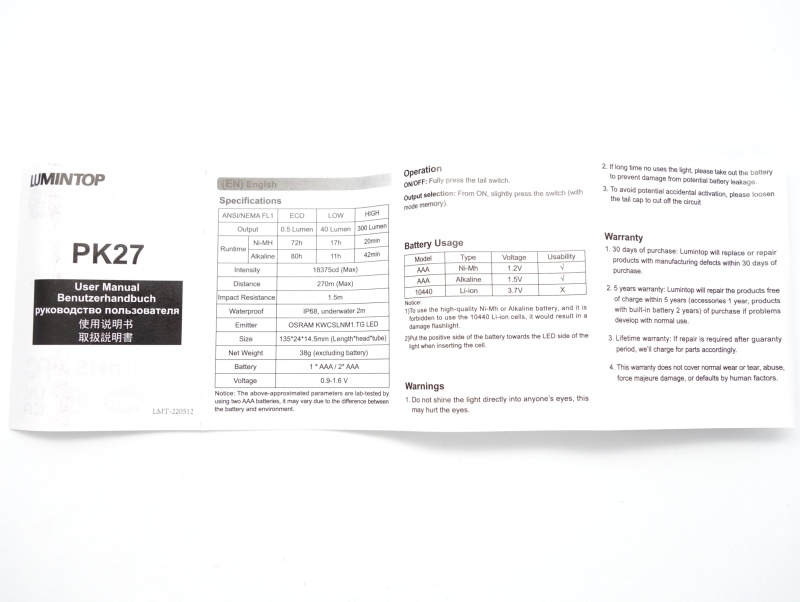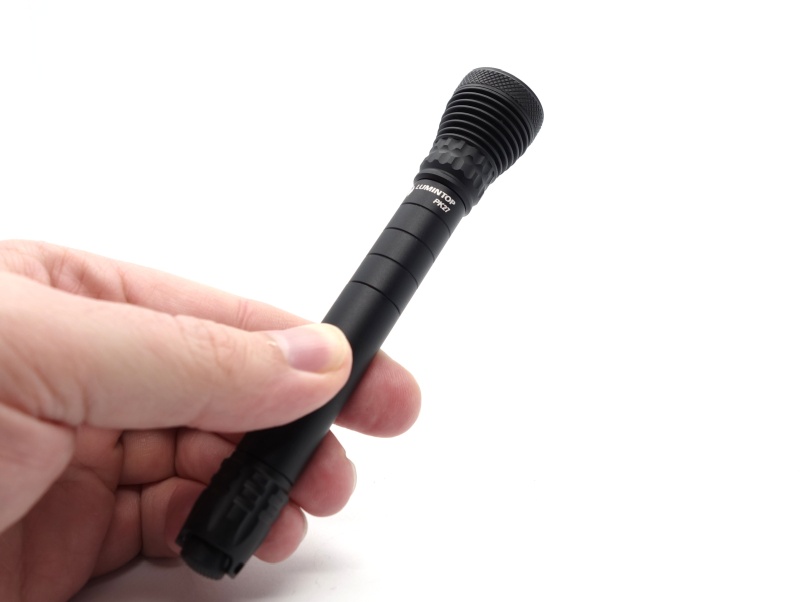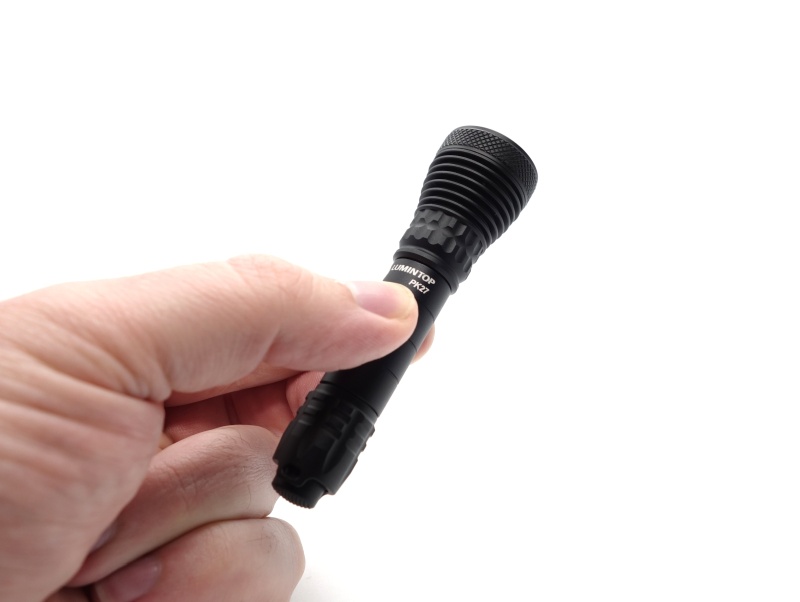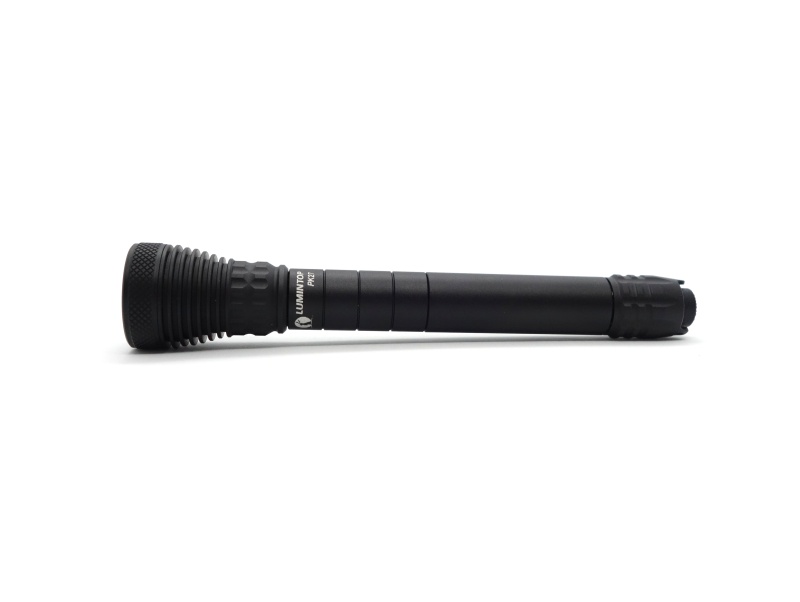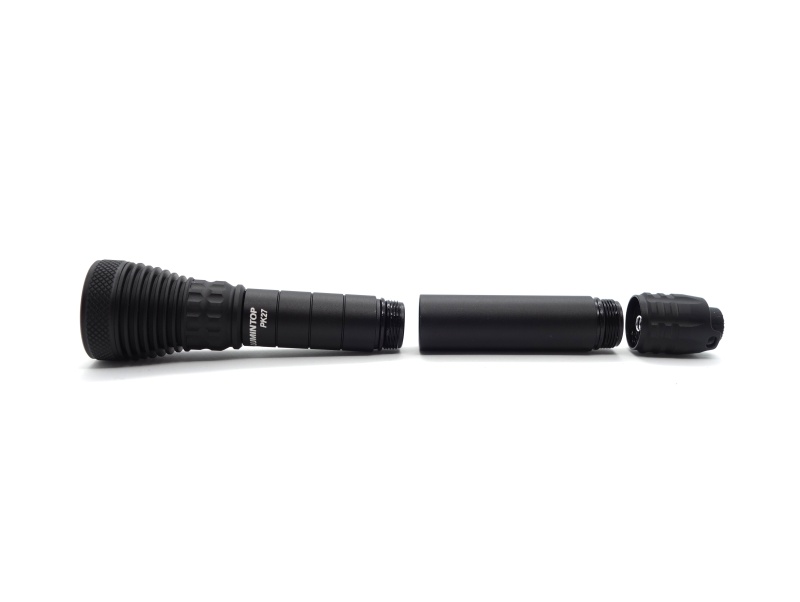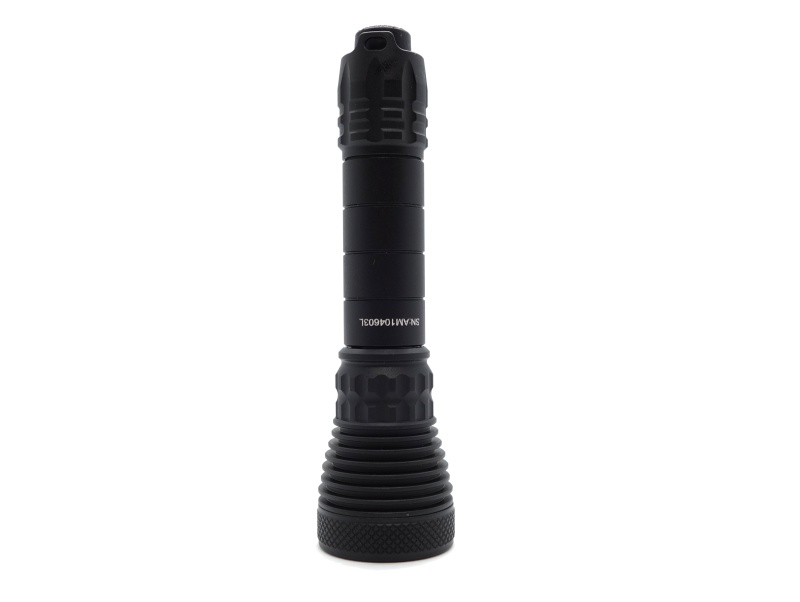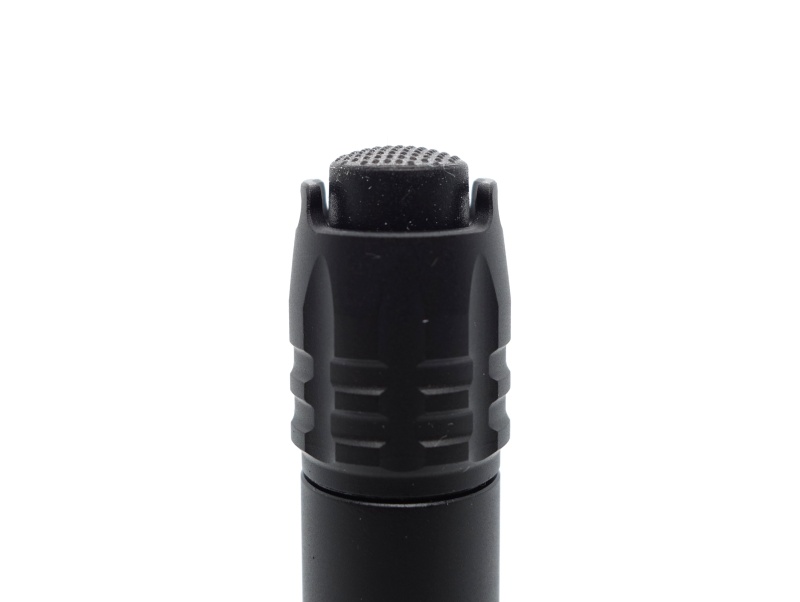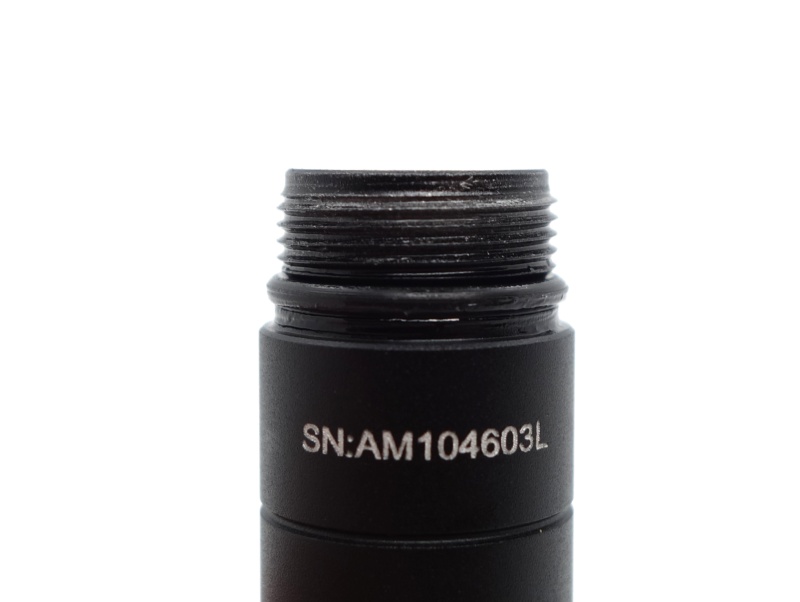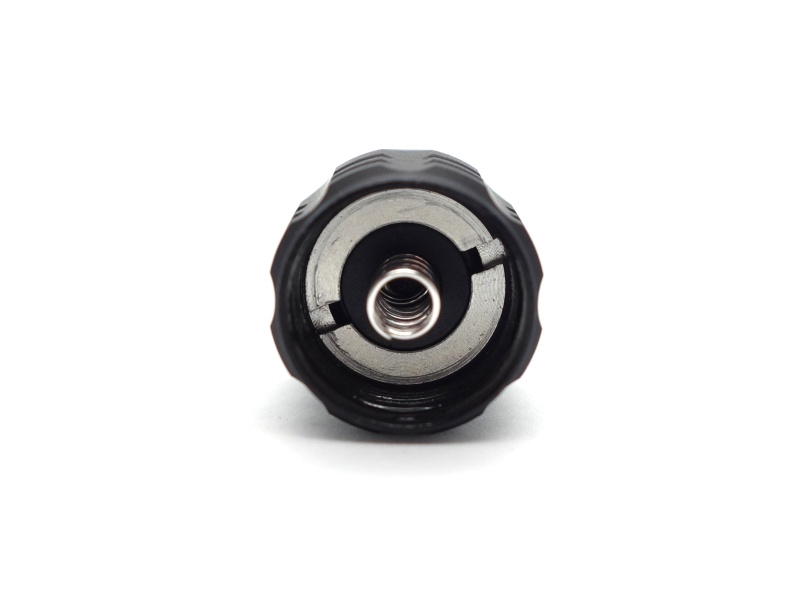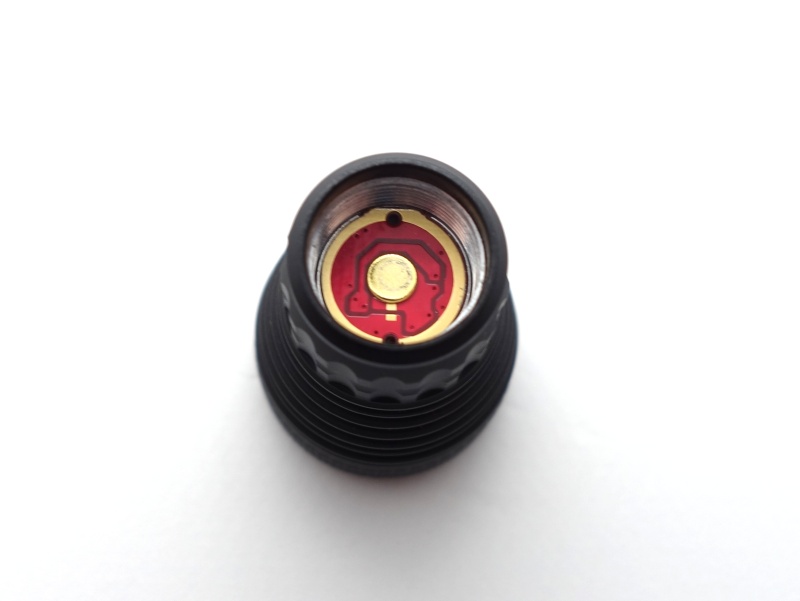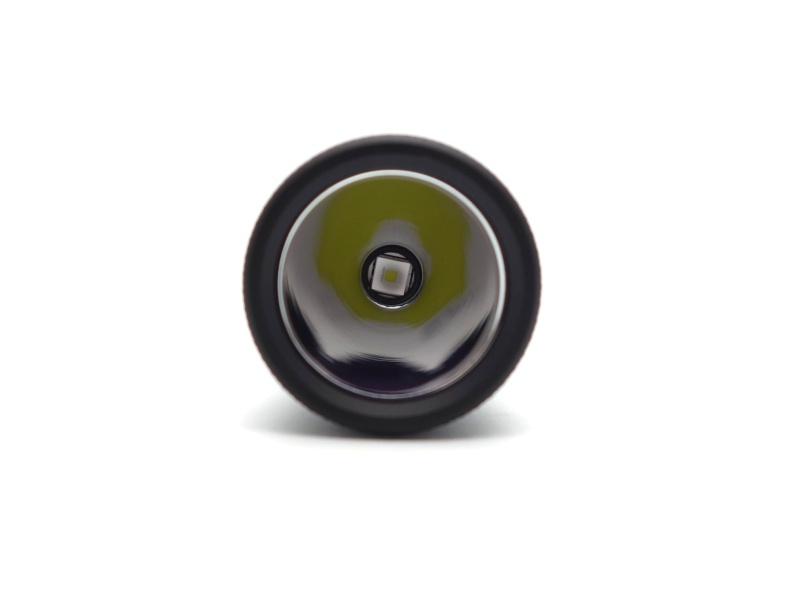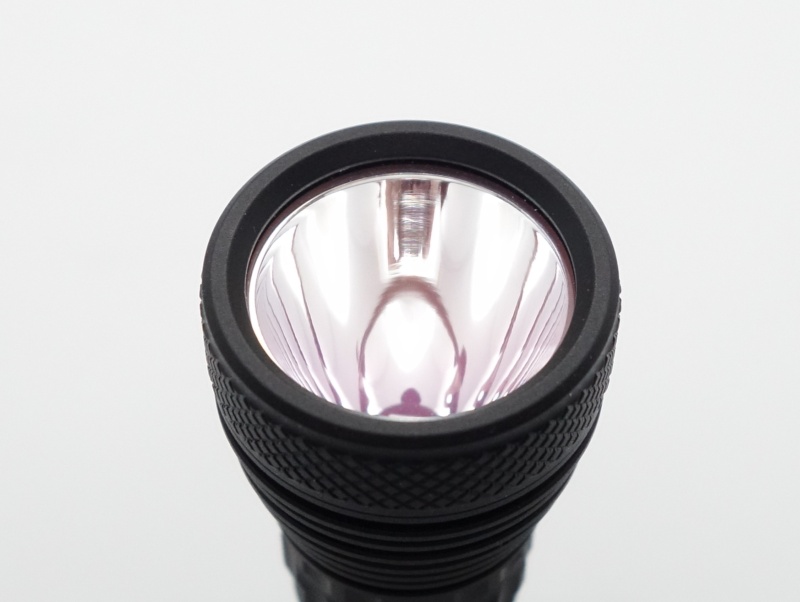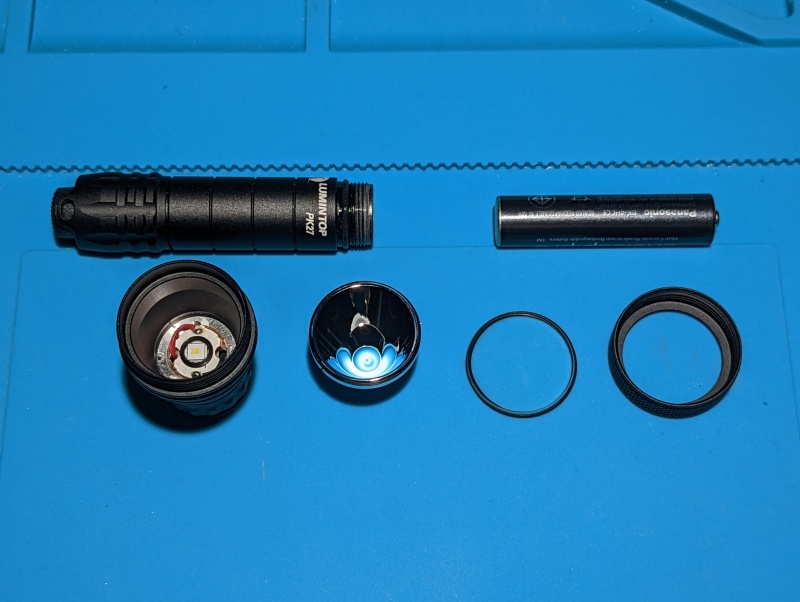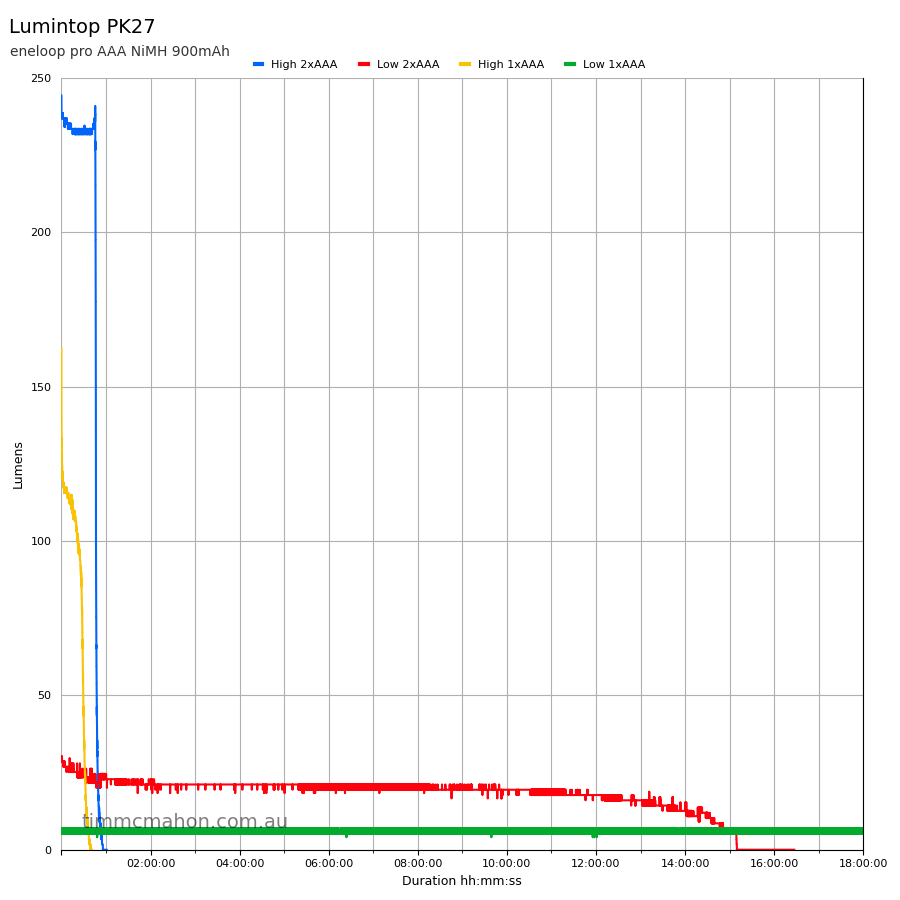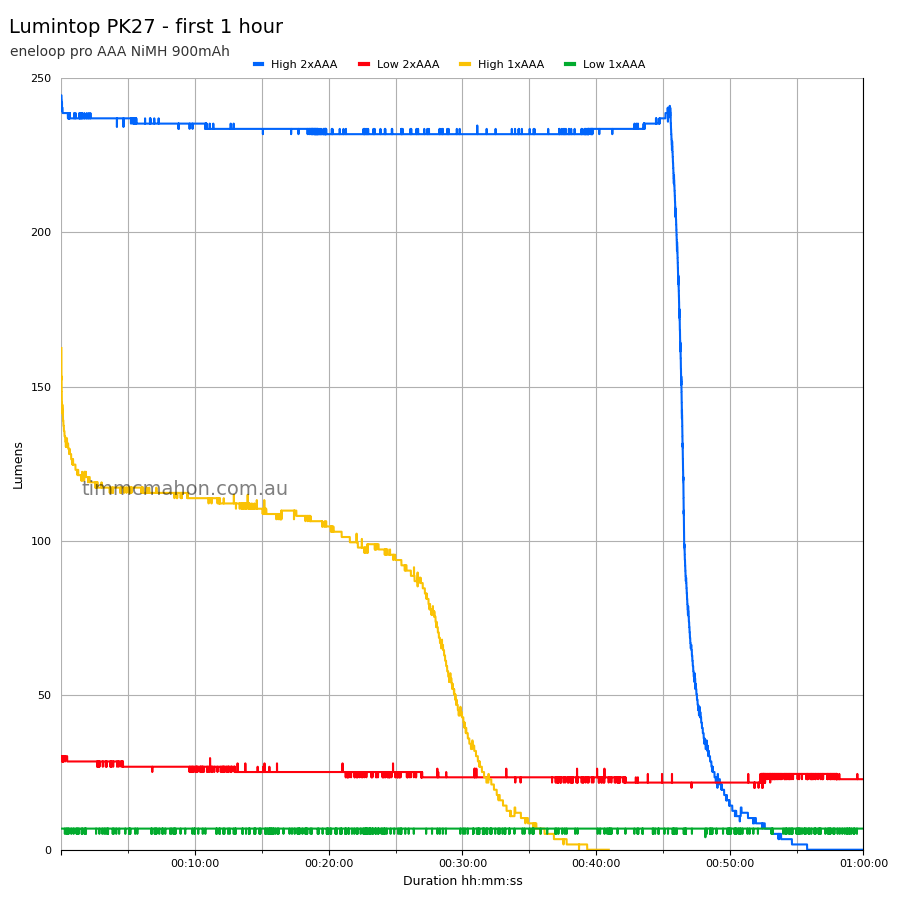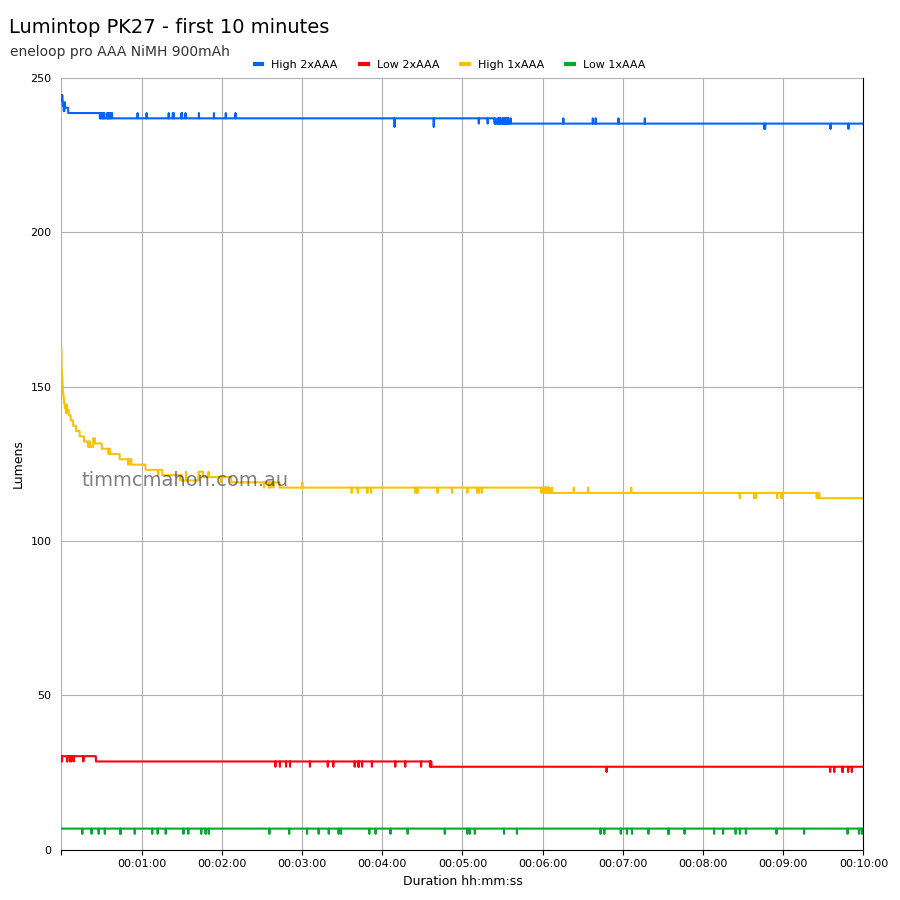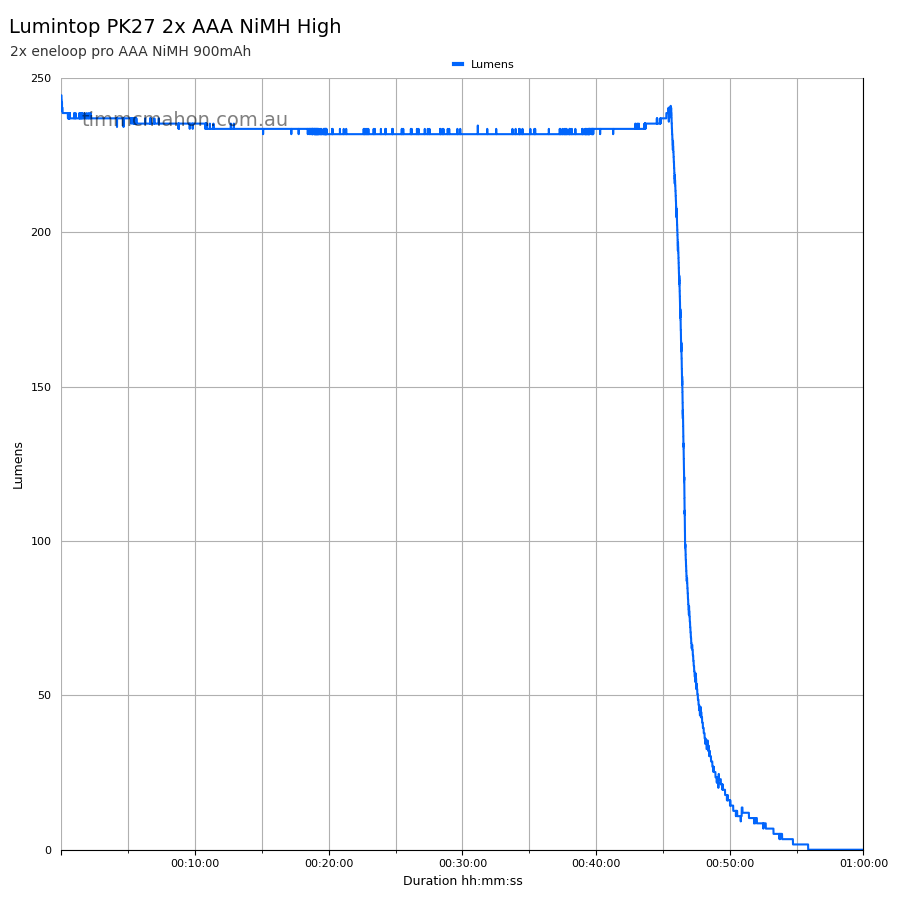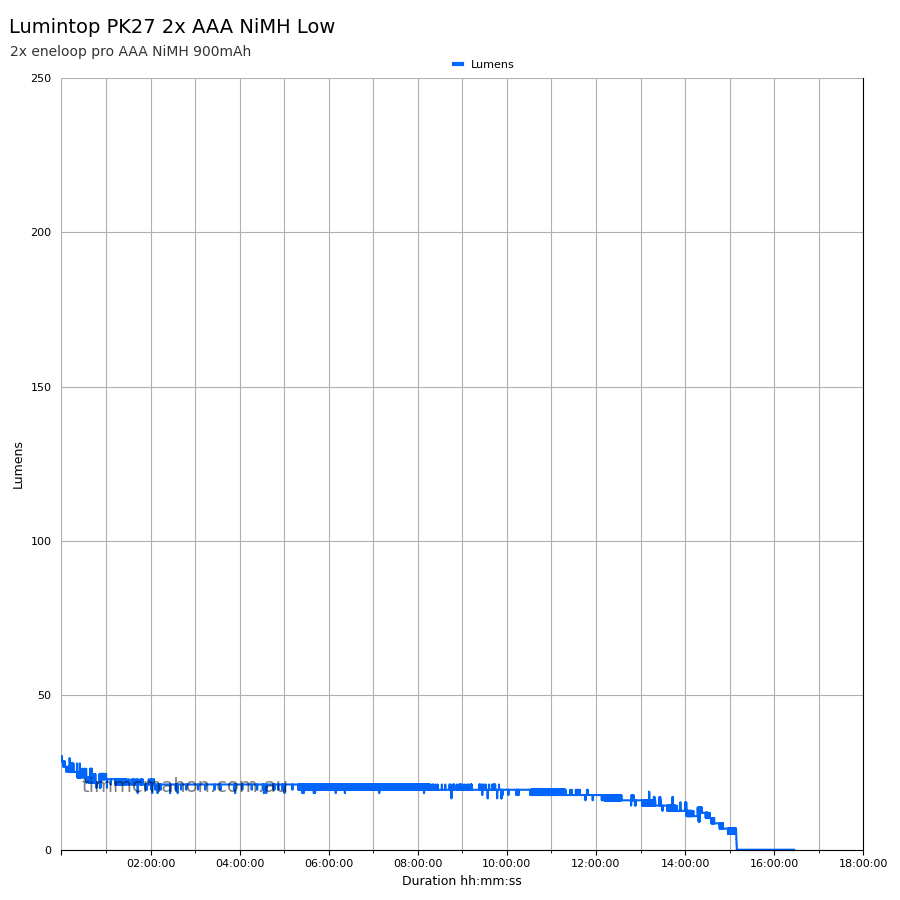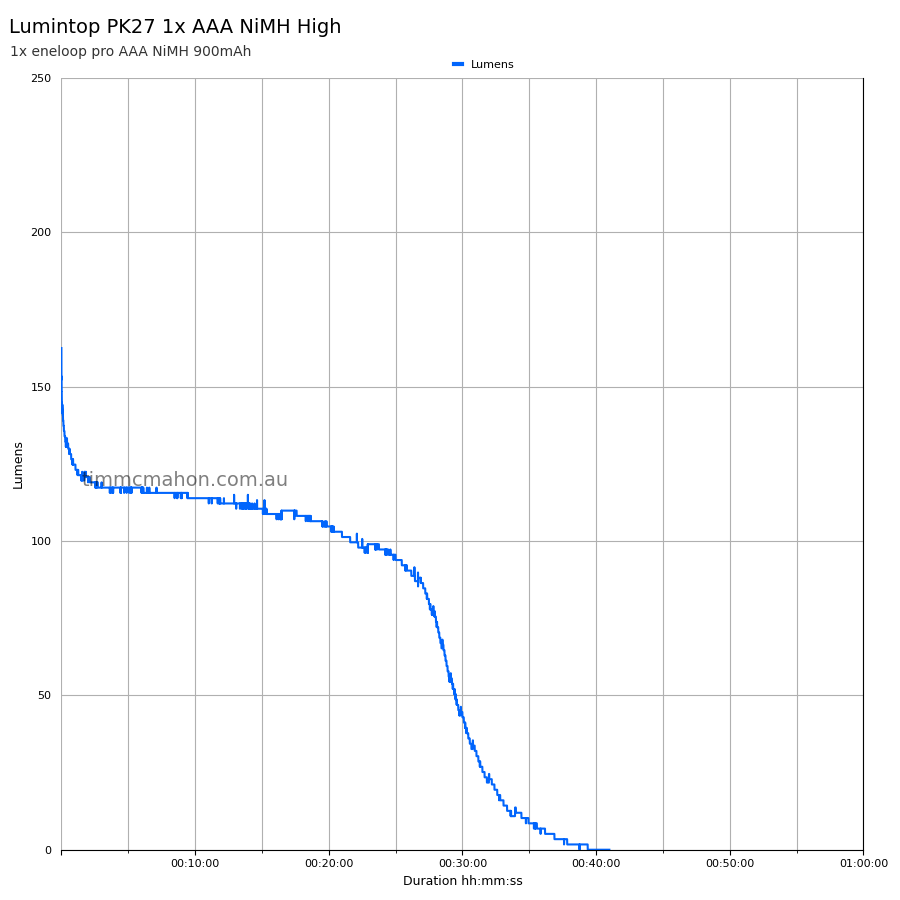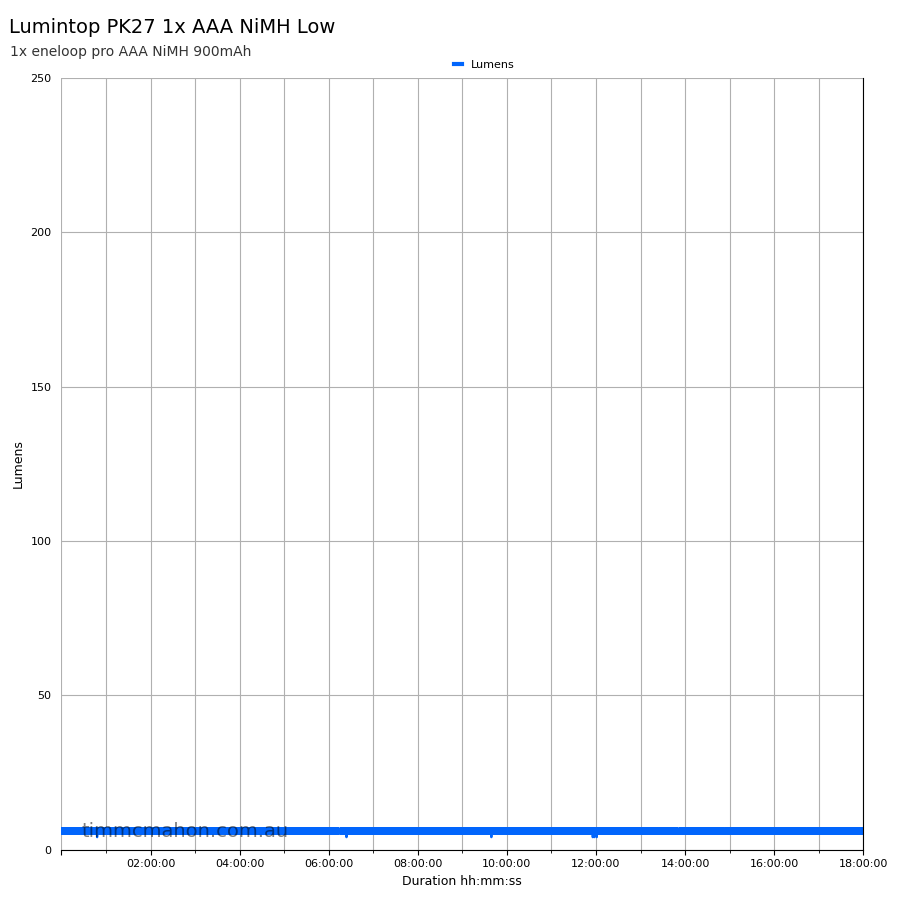Lumintop PK27 Review
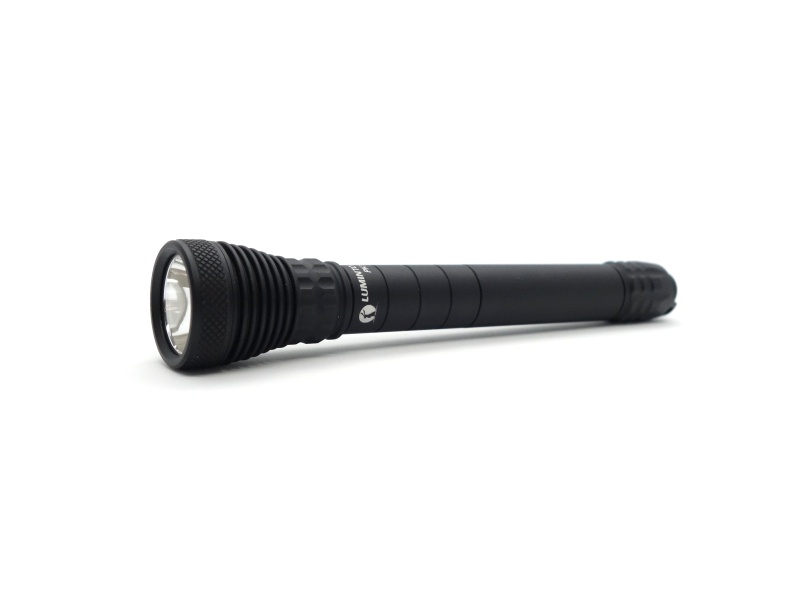
Lumintop PK27#
- Specifications
- Introduction
- Torch in use
- Build quality
- LED, bezel, lens, reflector and beam
- Size and comparison
- User interface
- Batteries and charging
- Performance
- Beamshots
- Conclusion
- Product page
Specifications#
| Brand/model | Lumintop PK27 |
|---|---|
| LED | Osram KW CSLNM1.TG |
| Maximum lumens | 300 lm |
| Maximum beam intensity | 18,375 cd |
| Maximum throw | 270 m |
| Battery | 2*AAA, 1*AAA. Alkaline or Ni-MH. |
| Onboard charging | No |
| Material | Aluminium |
| Modes | 3 |
| Blinkies | - |
| Reflector | Smooth |
| Waterproof | IP68 |
| Review date | January 2023 |
Introduction#
Have you heard about the Lumintop GT Nano? It is a ridiculously small pocket thrower. It takes a tiny 10180 battery and has an electronic side switch. Some people complained about the short battery life and standby drain (battery became flat without using the torch).
Lumintop later released a 10440 extension tube and made a thicker copper MCPCB to help the GT Nano deal with heat. This was a welcome improvement because it made the GT Nano slightly more practical instead of being a novelty.
With the release of the Lumintop PK27, Lumintop solved the standby drain issue by using a mechanical tailswitch and made a much more practical torch that supports standard AAA batteries.
The Lumintop PK27 is a small pocket thrower with a reverse-clicky tailswitch that takes either one or two Alkaline or Ni-MH AAA batteries. This allows it to be a small keyring torch or a penlight.
This torch was sent by Lumintop as a part of a giveaway. I have not been paid for this review nor have I held back my opinions of this torch.
Packaging#
The PK27 came in a light-brown cardboard box with Lumintop branding. A sturdy foam cutout has been used to protect the torch.
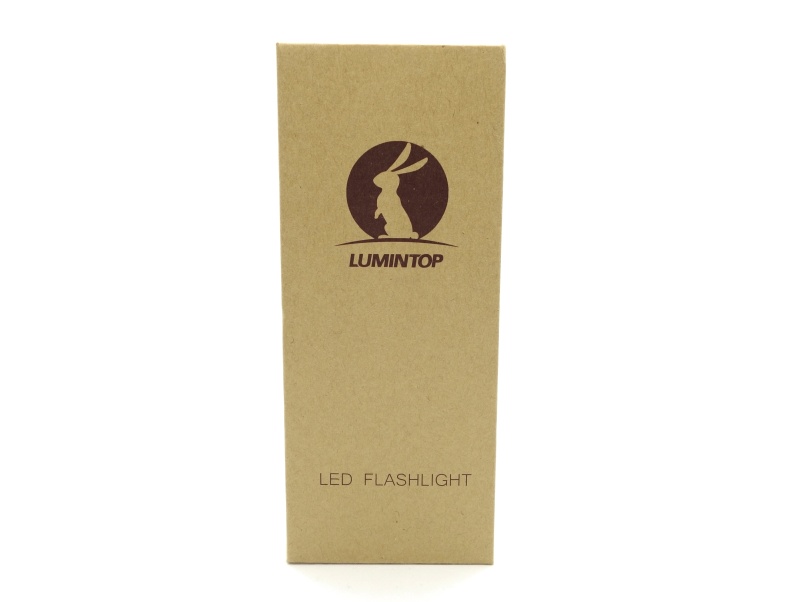
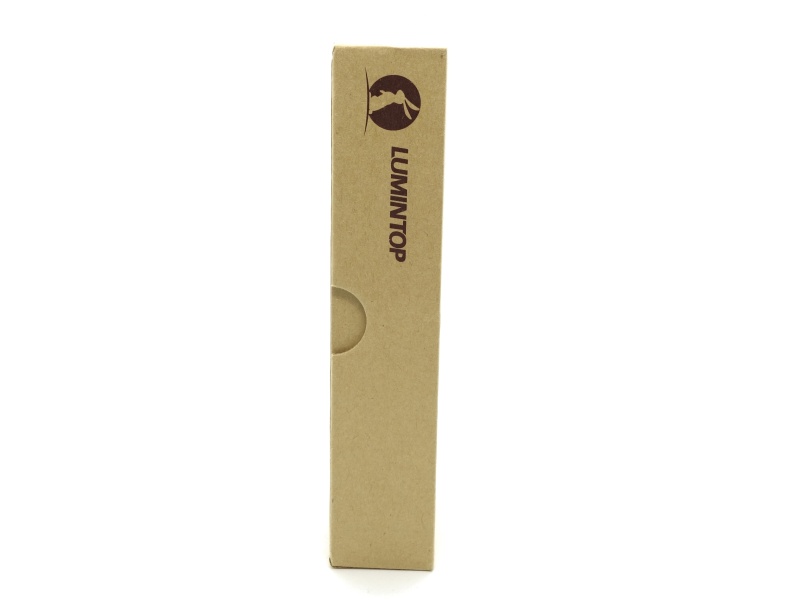
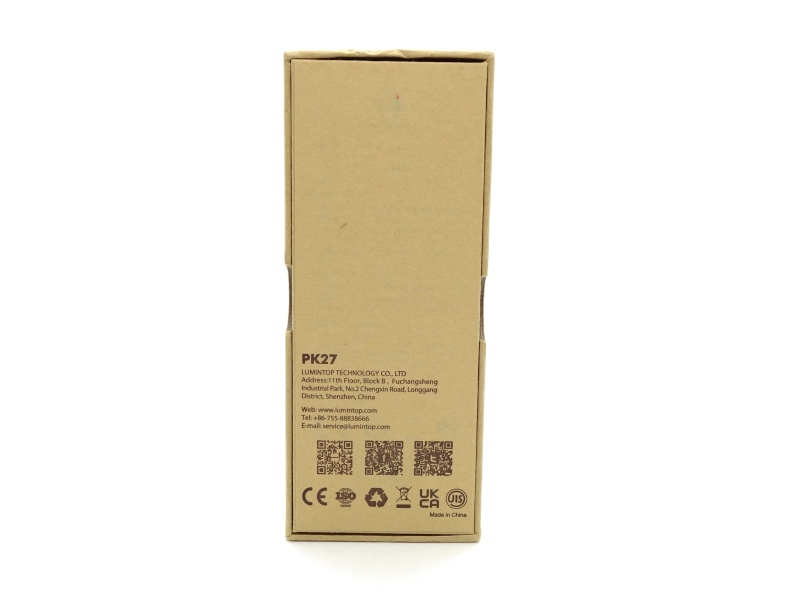
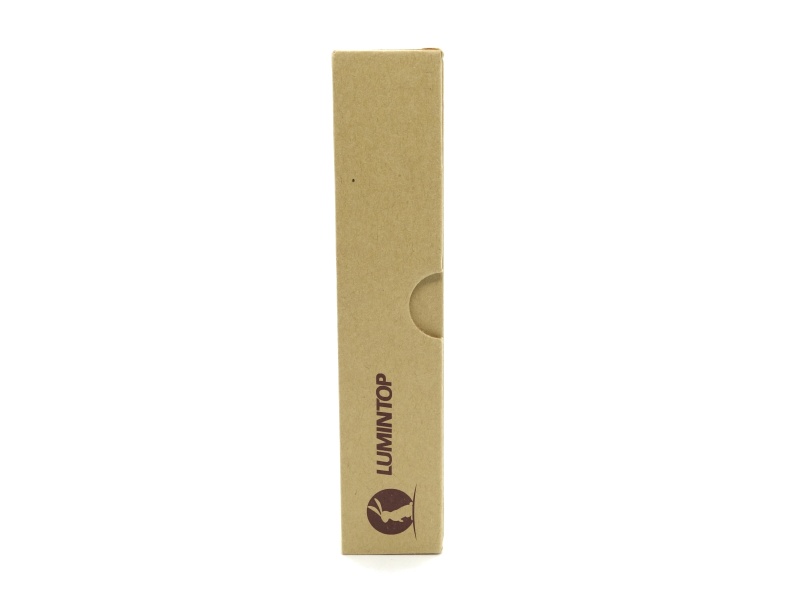
The following was included in the box:
- Lumintop PK27
- Lanyard
- Two spare o-rings
- User manual
Torch in use#
Disclaimer: I love AAA torches!
The Lumintop PK27 works as a penlight when two extension tubes are used but I have opted to remove a tube and use the torch as a small thrower on my keyring.
I found a tiny split ring, thread it through one of the lanyard holes on the tailcap, and attached it to a Nite Ize S-Biner MicroLock. This allows the PK27 to quickly detach from a keyring.
It would be even better if a split ring with a clip is included.
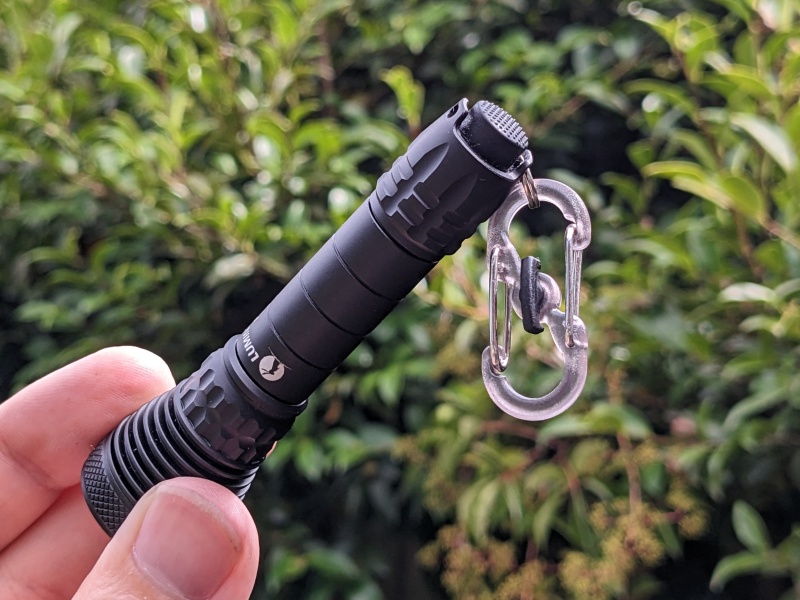
The reverse-clicky tailswitch gives an annoyingly sharp click noise when pressed. It feels similar to an Olight i3T switch but the i3T sounds slightly muted in comparison.
The torch cannot tailstand because the cover for the button sticks out beyond the two lanyard holes on the tailcap.
Build quality#
The Lumintop PK27 is constructed of aluminium. The body has a matte black anodised finish on both the outside and the inside. The torch feels smooth and there are no sharp edges.
There is plenty of grip on the head and tailcap.
The torch can be unscrewed into four parts: head, tube 1, tube 2, and the tailcap.
While the PK27 cannot tailstand, it can sit upright on a flat surface with the head face down.
The rubber switch boot has about 1mm of play where it is not firm but beyond that the switch is firm.
The threads on the tube came lightly lubricated. Anodising has started to wear off after unscrewing the parts a dozen times.
The two pads on the driver appear to be test points for positive and negative.
LED, bezel, lens, reflector and beam#
The Lumintop PK27 comes with a cool white Osram KW CSLNM1.TG emitter, a smooth reflector and a glass lens with a purple anti-reflective coating. This NM1 emitter is quite popular for throwers.
I was able to open up the head of the torch without much hassle.
The bezel does not appear to have any glue on the threads and it unscrews with a bit of force.
I had to pry the glass lens out with a fingernail because it was held down by the o-ring sitting between it and the reflector.
The reflector drops out to reveal a black gasket. The copper MCPCB is quite small compared to the shelf.
I have taken Correlated Colour Temperature (CCT) and Colour Rendering Index (CRI, RA of R1-R8) measurements with the torch positioned a metre away from an Opple Light Master Pro III (G3).
The CCT ranges from 5649K on Low to 6245K on High. CRI is around 67.
The Delta u, v is slightly positive (green).
The beam has an intense white hot spot, a white flowery corona, and a wide spill.
| Mode | CCT (K) | CRI (Ra) | x | y | Duv |
|---|---|---|---|---|---|
| Low | 5649 | 65.2 | 0.3289 | 0.3524 | 0.0073 |
| Medium | 5864 | 66.3 | 0.3242 | 0.3448 | 0.0056 |
| High | 6245 | 68.1 | 0.3172 | 0.3321 | 0.0026 |
Calculate Duv from CIE 1931 xy coordinates
Dimensions and size comparison#
Dimensions#
I took the following measurements using a vernier caliper.
| Measurement | Unit (mm) |
|---|---|
| Torch length (2xAAA) | 135.1 |
| Torch length (1xAAA) | 91.1 |
| Head diameter | 24.4 |
| Tube diameter | 14.5 |
| Tailcap diameter | 15.8 |
Weight#
I took the following measurements using a digital scale.
| Weight | Unit (g) |
|---|---|
| Torch 2x tubes | 36.4 |
| Torch 1x tube | 27.3 |
| eneloop pro AAA Ni-MH | 12.7 |
| Torch with 2xAAA | 61.8 |
| Torch with 1xAAA | 40.0 |
Size comparison with its competition#
From left to right: Lumintop PK27, ReyLight Pineapple Mini Copper, Olight i3T Brass, Wurkkos WK01, Manker E02 II, Sofirn C01S
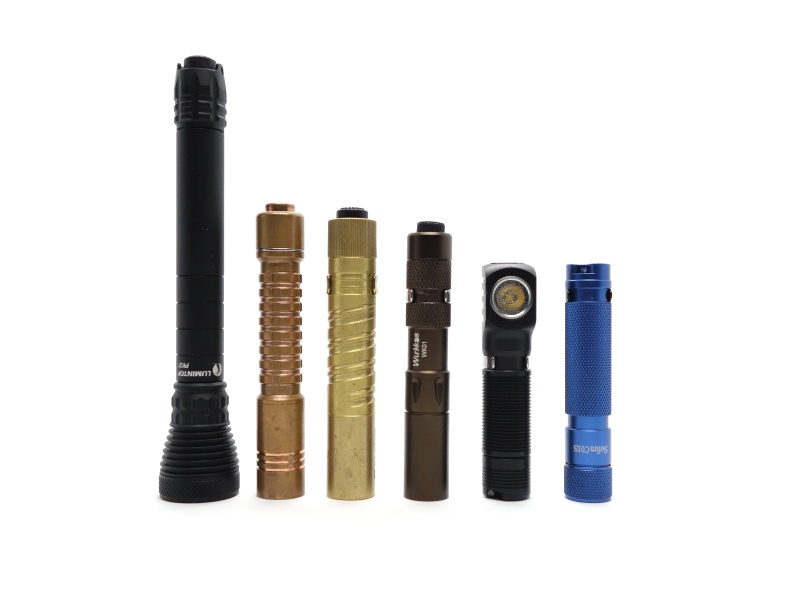
From left to right: Lumintop PK27, ReyLight Pineapple Mini Copper, Olight i3T Brass, Wurkkos WK01, Manker E02 II, Sofirn C01S
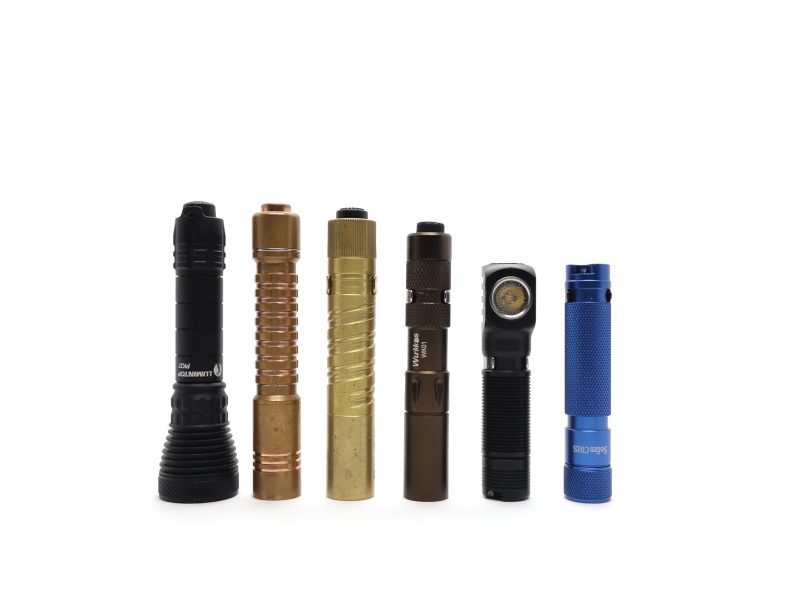
From left to right: Lumintop PK27, ReyLight Pineapple Mini Copper, Olight i3T Brass, Wurkkos WK01, Manker E02 II, Sofirn C01S
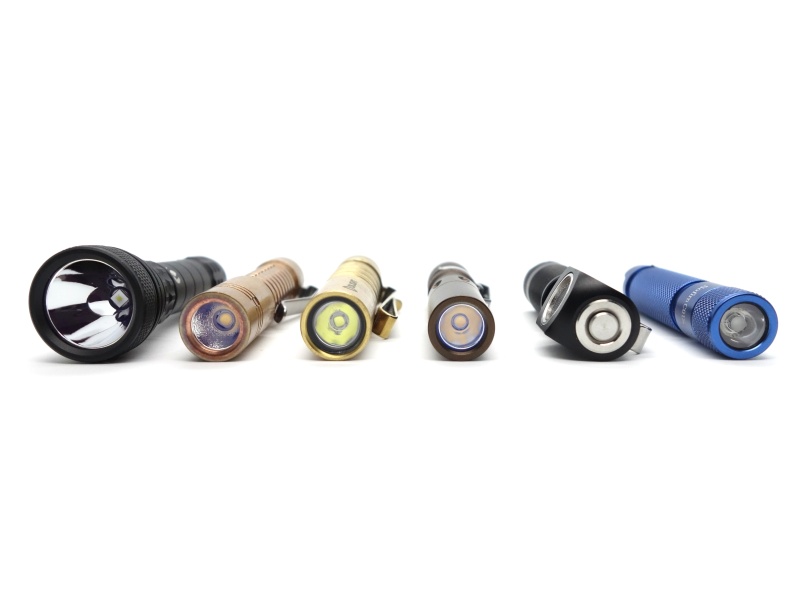
User interface#
A reverse-clicky tailswitch can be used to cycle the three modes from High to Low to Eco. The torch will remember the last used mode when turning it on.
| State | Action | Result |
|---|---|---|
| Off | Click | On (mode memory) |
| On | Half press | Cycle (High, Low, Eco) |
| On | Click | Off |
Low voltage protection#
There is low voltage protection. The torch turned off at 0.49V with a current of 35.0 mA. The current dropped to 40 µA at 0.21V. I tested low voltage protection by connecting the driver of the torch to a bench power supply and then by lowering the voltage from 1.5V to 0V.
PWM#
I did not notice any visible PWM (flickering).
What I like about the UI#
- It is simple to use.
What could be improved#
- Add the ability to change the ramp direction from High, Low, Eco to Eco, Low High.
- Add the ability to disable mode memory so that it always starts in Eco.
Batteries and charging#
Battery#
The PK27 did not come with any batteries. It accepts one or two AAA batteries. The AAA batteries must be either Alkaline or Ni-MH.
10440 3.7V Li-ion batteries cannot be used. Those may damage the driver.
I tried using a single flat top 10440 Li-ion cell charged to 4.189V and it worked. I measured 2.5A on High. The beam was more intense and it had a hint of purple that may be a sign of the emitter being over driven.
I also tried a button top 10440 Li-ion cell charged to 3.9V. 2A on High. The beam was more intense but there was no purple tint. The head heats up fast. I do not recommend using a 10440.
Charging#
There is no built-in charging.
Performance#
Specifications:
| ANSI/NEMA FL1 | Eco | Low | High |
|---|---|---|---|
| Light Output (lm) | 0.5 | 40 | 300 |
| Runtime (Ni-MH) | 72h | 17h | 20min |
| Runtime (Alkaline) | 80h | 11h | 42min |
| Beam Intensity (cd) | 18,375 | ||
| Beam Distance (m) | 270 |
Lumen measurements#
I used a UNI-T UT210E clamp meter to measure the current at turn on.
| Mode | Amps at start | Specs | Lumens @turn on | Lumens @30 sec | Lumens @10 min |
|---|---|---|---|---|---|
| 1x Ni-MH Eco | 0.02 A | 0.5 | |||
| 1x Ni-MH Low | 0.05 A | 6 | 6 | 6 | |
| 1x Ni-MH High | 2.22 A | 162 | 131 | 113 | |
| 2x Ni-MH Eco | 0.01 A | 0.5 | |||
| 2x Ni-MH Low | 0.09 A | 30 | 28 | 26 | |
| 2x Ni-MH High | 0.97 A | 244 | 238 | 236 |
I used eneloop pro AAA 1.2V Ni-MH cells for testing.
I recorded an initial value of 0.5 lm for Eco when using one and two AAA Ni-MH cellls and then stopped the recording. My DIY lumen tube cannot accurately measure below 1 lumen.
Standby drain#
There is no standby drain. This torch has a mechanical tail switch.
Runtime graphs#
I used my own DIY lumen tube with a TSL2591 sensor and forked bmengineer’s project RuTiTe to record runtimes.
Note: Lumen measurements may be off by 10% with my DIY lumen tube.
High maintained about 238 lumens for 45 minutes with 2xAAA Ni-MH batteries.
High maintained a little over 110 lumens for almost 20 minutes before dropping and switching off at 39 minutes 26 seconds with 1xAAA Ni-MH battery.
Low maintained about 26 lumens for almost 12 hours before dropping and switching off shortly after 15 hours with 2xAAA Ni-MH batteries.
Low maintained 6 lumens for 18 hours with 1xAAA Ni-MH battery. I stopped recording at 18 hours.
The runtime duration that I observed is similar to Lumintop’s estimates but the light output was lower than expected. The lumen measurements may have been lower because I tested with Ni-MH batteries. I do not know whether Lumintop used Alkaline or Ni-MH batteries for testing.
I have not tested Eco runtimes due to the 70+ hour estimate by Lumintop.
Throw#
I took lux measurements with a UNI-T UT383BT at 30 seconds. Eco was measured at one metre. Low and High were measured at two metres.
| Mode | Specs (cd) | Specs (m) | Candela measured (cd) | Distance (m) |
|---|---|---|---|---|
| 1x Ni-MH Eco | 19 | 8 | ||
| 1x Ni-MH Low | 336 | 36 | ||
| 1x Ni-MH High | 8,900 | 188 | ||
| 2x Ni-MH Eco | 20 | 8 | ||
| 2x Ni-MH Low | 1,988 | 89 | ||
| 2x Ni-MH High | 18,375 | 270 | 15,756 | 251 |
The beam intensity and throw is slightly lower than expected. Perhaps Lumintop used Alkaline AAA cells for testing.
Beamshots#
I went to a local park and aimed the Lumintop PK27 at a tree 70 metres away while using High.
Beamshots were taken using a Sony RX100M2 using 3.2", f3.2, ISO 800, 5000K WB.
Lumintop PK27 (High 2xAAA)#

Acebeam Pokelit 2AA (High)#

Acebeam E70 Mini (Turbo)#

Beamshot comparison video#
Here is a video comparing the Acebeam Pokelit 2AA and the Lumintop PK27 on my YouTube channel. I reviewed the Acebeam Pokelit 2AA last month.
Conclusion#
The Lumintop PK27 is a practical AAA pocket thrower that fits on a keyring.
I highly recommend it if you are looking for a AAA pocket thrower!
Pros:#
- Good build quality
- Small size
- Throws well for the size
- Simple user interface
- Supports common AAA batteries
Cons:#
- User interface (I prefer cycling Eco, Low, High)
- Low CRI
